
Original Link: https://www.anandtech.com/show/2582
Prelude to a Review-
The AMD 780G chipset got us excited about integrated graphics platforms again after its release last March. You can imagine our surprise when AMD contacted us in April asking what we would like to see in the next IG chipset scheduled for release this year. Of course, we obliged AMD with our wish list that included everything from 8-channel LPCM audio over HDMI to HD 3650 or higher-level performance.
We also requested a new Southbridge with improved RAID performance along with RAID 5 capability. More importantly, we wanted a chipset that could run true CrossFire and bridge the gap between the budget IGP and enthusiast level markets. In other words, we wanted a chipset that could serve the multimedia and small form factor audience in a uATX form factor or provide top-flight performance and features for the enthusiast in an ATX form factor. You know, something like the NVIDIA 750a SLI product or Intel’s P45 only with an IG unit.
AMD listened intently and replied they had something that might just fit our requirements. We were even more surprised to learn that it was arriving in late June under the 790GX moniker. Yes, we had to wait until early August but estimated release schedules in this industry have a tendency to be overly optimistic. For those diehard AMD fans, the delay in the release of the 790GX has been frustrating. Mainly due to the fact that rumors swirling around the internet about the performance and capabilities of the 790GX have been a bit more optimistic than the release schedule.
Unfortunately, speaking of release schedules, we think later August would have been a better target after spending the last week testing our 790GX products. In fact, we ran across so many problems that our article today is a preview of the chipset capabilities. We will follow-up quickly (Editor- no more food or Guitar Hero until this is finished) with a full review of products from Gigabyte, ASUS, Biostar, and Foxconn.
The majority of our problems center on BIOS tuning and driver related maladies. After speaking extensively with the motherboard suppliers, we are certain the BIOS releases that arrived late last night or those coming today will address problems ranging from NB multipliers/HT Ref Clock change requests not accepted via BIOS or AOD to 8GB compatibility issues along with other minor performance hindrances like memory SPD settings not being read correctly when overclocking. PCI peripheral support with a couple of network and audio cards is also giving us trouble. Of course, BIOS tuning can take you only so far and the requirement for solid drivers is necessary.
The 8.521.1 driver set, aka Catalyst 8.8 beta, has significant performance optimizations for the 790GX plus full support for the new C1E power savings mode, PowerPlay, and deep sleep instructions for the SidePort memory, umm Performance cache. As is the case with beta drivers there are liable to be various features that might not work correctly. One important feature that failed to work properly for us was CrossFire operation with our HD 4850 or HD 4870 cards.
Other problems ranged from proper C1E implementations and S1/S3 resume issues to HDMI repeater/screen resolution setups with commercial BD playback software. AMD informed us late today that we should roll back to the 8.7 drivers for testing all items but C1E. Of course, this meant graphics, power management, and performance testing on our test platforms just got tossed out the window. It also meant a reduction in IG performance around 3%~5% and some quirky results with C1E and Cool-n-Quiet enabled.
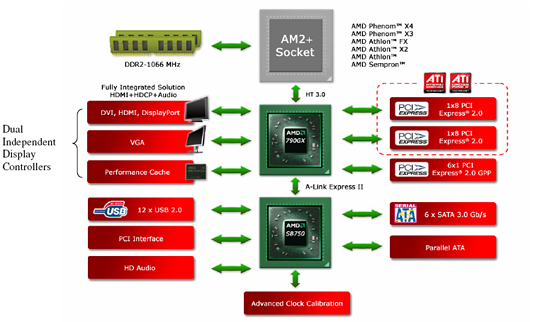
On a side note, we still do not have the latest version of AOD working correctly with any of our 790GX and 9950BE combinations after a stellar appearance on the 790FX board we utilized in our SB750 preview. Actually, these problems are typical during the launch of a product. It just seemed that in our case the perfect storm brewed as it was nearly impossible to close out each benchmark session without running into a problem. We sailed through discreet graphic card testing with the beta drivers but were stymied with the inability to run CrossFire although Hybrid CrossFire worked fine.
Our power draw tests revealed three different sets of numbers, not an explainable difference due to a board’s components, but a 30W difference at idle with the same components and BIOS settings. RAID 5 testing resulted in several different sets of IOMeter results between the boards that we are still investigating. Problems even carried over to HDMI output through our receivers although it appears rolling back to the 8.7 drivers today cured those issues.
In our estimation, the BIOS and drivers needed some additional brewing time before the product release. While it may seem we are picking on AMD, this occurs with NVIDIA and Intel also. In fact, we could devote an entire page to our early experiences with G45. However, all this said, we did find the motherboards to be extremely stable in the normal course of testing with major applications that typical users will utilize. In addition, performance from the integrated graphics unit is simply superb considering AMD’s competition. We did not discover any show stopping problems that would prevent us from purchasing the product at this time. Just beware that a BIOS spin and updated driver release will be required to get the most out of the board’s additional features.
So let’s take a look at the chipset specifications of the 790GX chipset.
780G, err 790GX Northbridge
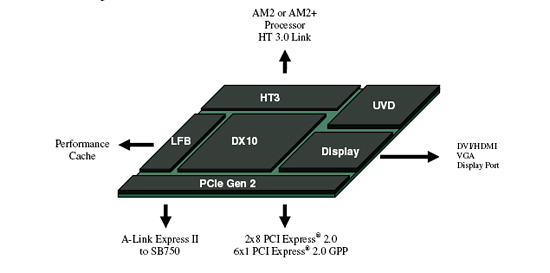
The biggest change AMD made in designing the 790GX is an increase in core clock speed from 500MHz to 700MHz. In essence, AMD is speed binning the 780G chipsets and those that pass end up with a 790GX silkscreen stamp. Due to the improved performance, the graphics processor also has a name change bump from Radeon HD 3200 to, wait for it, Radeon HD 3300.
The 790GX still utilizes a 55nm TSMC half-node process with transistor counts hitting 205 million. The Northbridge contains 26 lanes of PCI Express 2.0 connectivity with 16 lanes reserved for graphics via a single x16 link or a dual-x 8 CrossFire configuration. Six lanes are available for x1 links for expansion slots or onboard peripherals. AMD reserves the remaining four links for use in the A-Link Express II interface to the SB750 Southbridge.
Hybrid CrossFire returns but support is still limited to the HD 2400 and 3400 based cards. The improved clock speeds of the HD 3300 and performance cache allows a user with a HD 3470 to get performance near that of a HD 3650. The problem is that most HD 3470 cards are selling for around $50 and recent price reductions have brought the price of the HD3650 down to $65, in essence negating the previous price to performance advantages. We doubt anyone will take advantage of this feature since the chipset is targeted primarily for the performance sector where most users will take advantage of a single performance oriented card like the HD 4850 or a CrossFire configuration instead of Hybrid CF if the integrated graphics were not fast enough.
Sideport Memory returns energetically in the 790GX products, this time at the request of AMD. While an option on the 780G boards, AMD has persuaded the motherboard suppliers to include sideport memory in at least one 790GX product from their lineups. Along with this inclusion comes a new name, Performance Cache. The performance cache resides on a 16-bit memory interface that can utilize DDR2 or DDR3 memory. The majority of motherboard makers will use DDR3-1333 in a 128MB configuration. While performance between DDR2 and DDR3 is about the same in this particular application, DDR3 offers additional power savings.
Depending on the processor and HT Link utilized, sideport memory will generally improve performance across the board up to 5% - not just in games, but in video decoding capabilities as well. Besides performance improvements resulting from the local frame buffer instead of shared system memory, the new driver design allows improved Deep Sleep capabilities with the active frame buffers being stored in the performance cache.
As with the 780G, the 790GX AMD features Unified Video Decoder 2.0 (UVD 2.0) capabilities that include hardware acceleration for decoding VC-1, H.264 (AVC), WMV, and MPEG-2 sources up to 1080p resolutions. Advanced de-interlacing is available when using a Phenom processor. HDMI 1.3 compliance continues with xvYCC color space support and 4:2:2 capabilities. On the audio side, the HDMI interface offers support for 2-channel LPCM, Dolby Digital 5.1, or DTS 5.1. AMD still does not support Multi-Channel LPCM and it continues to be a thorn in our side.
Rounding out the video capabilities of the 790GX is analog output, DVI/HDMI interfaces, internal or external TMDS, and integrated DisplayPort capabilities. The HD 3300 features dual independent displays that allow resolution, refresh rates, and display data to be completely independent on the two display paths. AMD provides HDCP support with on-chip key storage for DisplayPort, DVI, or HDMI interfaces but it is regulated to a single interface during playback operations. ATI SurroundView is fully supported when utilizing a Radeon based discrete card that allows the system to drive up to four monitors.
The Radeon HD 3300 graphics processor features a DX10 compliant unified shader model 4.0 graphics core. This architecture contains 40 stream processors from two shader SIMDs. The core features 128-bit floating point precision for all operations, a command processor for reduced overhead, DXTC and 3Dc+ texture compression, texture support up to 8192x8192, and a fully associative texture and Z/stencil cache.
The single texture and ROP units are capable of handling four texels and pixels per-clock, respectively. This allows up to 16 texture fetches per clock cycle and up to 128 textures per pixel. The one modification AMD made compared to the RV610 core on the HD 2400 series is the vertex and texture caches are fully associative instead of separate. Other technical goodies include early Z-test, Re-Z, Z range optimization, and Fast Z-clear operation.
There are eight render targets (MRTs) with anti-aliasing support, along with lossless Z and stencil compression. The HD 3300 features multi-sample anti-aliasing (up to 4 samples per pixel), custom filter anti-aliasing, adaptive super-sampling and multi-sampling, along with Super AA when using Hybrid CrossFire. HDR rendering is supported for all anti-aliasing features, although like current HD 2400 products, the performance hit for using AA is significant in certain games.
Texture filtering features include 2x/4x/8x/16x adaptive anisotropic filtering modes with up to 128 taps per pixel support. Bicubic, sRGB, and percentage closer filtering are featured along with 128-bit floating point HDR support. Finally, the HD 3300 includes a programmable tessellation unit and an accelerated geometry shader path for geometry amplification.
Let’s move on the biggest improvement since sliced bread, well almost.
SB750 Southbridge
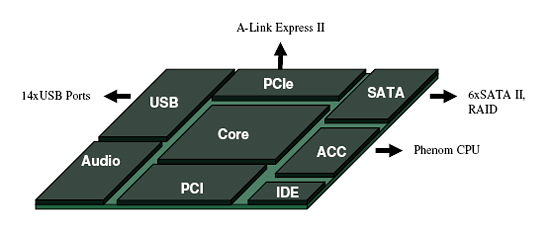
While technically a new part, the SB750 appears to us to be a point upgrade to the SB700. However, it is a major improvement over the SB600. Anyway, let’s get into what has changed and what has not.
The SB700/750 features six SATA 3.0Gb/s ports, up from four on the SB600, with the ability to reserve up to two of those ports for eSATA connectivity. AHCI performance and setup is much easier now and we have not experienced the same problems that plagued the SB600. Drives can be set up in RAID 0, 1, or 10 and RAID 5 now makes its appearance in the SB750. RAID 5 works well for a host based controller and even outperforms the ICH10R in early testing with a three drive array, but four or more drives is resulting in some odd behavior that we are trying to figure out now.
Still missing in action is a native interface for networking support. AMD continues to use an external PHY and MAC for network operations. Although performance is similar to the NVIDIA and Intel solutions, this setup does incur a cost penalty for the motherboard suppliers.
The major improvement in the SB700/750 series over the SB600 is the increase in USB 2.0 performance and the number of ports available. The new dual-channel controller features 12 USB 2.0 capable ports and 2 specific 1.1 ports for compatibility reasons. USB 2.0 performance is up to par with the Intel and NVIDIA solutions.
A single PATA channel provides native IDE support for up to two drives. This channel supports PIO, multi-word DMA, and Ultra DMA 33/66/100/133. Six PCI lanes are still included although we doubt a board manufacturer is going to offer that many. AMD dropped HyperFlash support on the SB700 to make way for the new Advanced Clock Calibration interface.
The SB700/SB750 features four PCI Express lanes for the A-Link Express II interconnect between the Northbridge and Southbridge, but like the current 790FX/780G series, those four lanes are based on PCI Express 1.1 specifications. That means the interconnect bandwidth is capped at 2GB/s, half of what it would be in a PCI Express 2.0 configuration.
Finally, we have the High Definition Audio controller carried over from the SB700 that allows up to 16 channels of audio output per stream. The controller supports up to four codecs with sample rates reaching 192kHz at up to 32-bits per sample.
ACC-
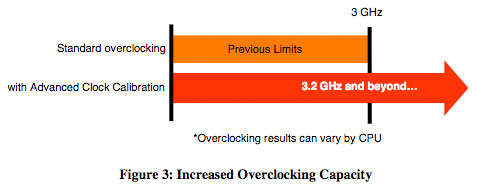
The most drastic and perhaps most important change on the SB750 is the new Advanced Clock Calibration interface that promises additional overclocking headroom or lower voltages with the Phenom processor series, especially the BE products. We have seen clock improvements ranging from 100MHz to over 500MHz depending on the processor we utilized.
The SB750 now has a direct 6-pin interface to the AM2+ socket on the motherboard, there are now pins on the Phenom CPU that connect directly to the SB750. These pins were previously unused and are now used as a means of communication between the South Bridge and the CPU. The SB750, in combination with an updated BIOS, can now override some of the CPU's internal settings which can potentially increase the overclocking headroom of the chip.
AMD says that the settings tweak doesn't impact performance and doesn't change thermals or voltages, it simply can allow a Phenom processor to clock higher when overclocking. The BIOS exposes the parameter being changed, which AMD refers to as the Advanced Clock Calibration (ACC) value. Typically this value has a range of -2 to 0, on motherboards with the SB750 that support ACC the value can be set from -12 to +12. Higher numbers should allow for higher clock speeds, while lower values should allow for lower voltages/lower power operation.
Even after a full press court for the last three weeks, AMD will not tell us what this value actually adjusts - simply stating that it makes it easier for the CPU to run at higher speeds. Based on AMD's careful choice of words, it would seem that adjusting the ACC somehow changes the acceptable margins of operation for the CPU cores (the value can be changed on a per-core basis in AOD or BIOS). By loosening these margins, however it is able to do so; the SB750 + ACC combo can enable many Phenom processors to operate outside of their normal overclocking margins. In fact, AMD is confident enough about the technology that they are willing to state publicly that on average; a 100MHz to 300MHz increase in clock speeds is attainable by the user after some tweaking. In fact, we totally agree with these numbers after extensive testing.
The SB750/ACC trick doesn't work on anything other than Phenom processors, and it works particularly well on the Black Edition processors. While AMD didn't rule out eventually enabling this on K8 based cores, it is a Phenom-only option for now. Reaching higher clock speeds is more of a top priority for Phenom, and it's unclear whether or not whatever AMD is doing here can even work on K8 if they tried.
AMD also committed to enabling similar tweaks for upcoming 45nm based Phenom parts, implying that this was not a short-term solution to the clock speed problem. At the same time, AMD implied that the tweaks that the SB750/ACC feature enables could be incorporated into the manufacturing chain and actually implemented in hardware.
Microprocessors are designed to operate in even the most extreme of conditions, AMD seemed to imply that its ability to adjust the ACC value somehow changes this. Curiously enough, AMD cited "competitive concerns" as a reason why it would not disclose exactly what's going on with this new overclocking feature. We still cannot help but wonder if it is because AMD is going a little too far in the sacrifices, it is willing to make in the quest for higher clock speeds.
We Need to Talk -
How about a short recap. The 790GX Northbridge is actually a 780G that has its stock core clock speed increased from 500MHz to 700MHz along with a graphics core name change from Radeon HD 3200 to HD 3300. Sideport Memory, now called Performance Cache, is a “requested” feature on the boards that improves IG performance about 5% on average, sometimes less, sometimes more. The SB750 Southbridge is basically a SB700 with RAID 5 operation and the new ACC interface. Mix the two parts, stir, and you have the highest performing integrated graphics solution on the market today.
However, the 8.521.1 driver set that enables all of this goodness is still beta and has a few warts that will be fixed very shortly. In addition, needed BIOS tuning by the various manufacturers is well underway. In fact, we have already received major BIOS updates today from each board supplier that at first pass have solved a multitude of problems we asked the manufacturers to address.
Stock operation of the boards we are testing has been extremely stable, the majority of our problems that were not driver related occurred when overclocking the system or trying off-center combinations of components or settings. Our initial experiences lead us to believe that the release of the 790GX was about a week to ten days too early. However, our initial feedback to AMD and the motherboard suppliers have been addressed quickly and professionally. So much so, that we would not hesitate in purchasing this platform if it addresses your requirements.
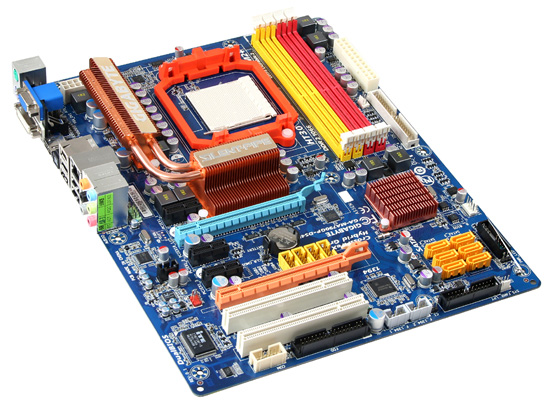
Getting back to our original requests to AMD when asked what we would like to see in the next chipset. They addressed most of our requests from lower power consumption to improved IG performance. We ended up getting a bonus called Advanced Clock Calibration for our clock challenged Phenoms and a platform design that can run 140W TDP processors on a four-layer board.
Our price point request of $100 to $135 is almost a reality. However, for the multimedia crowd, our passionate requests for multi-channel LPCM audio over HDMI will have to wait until the next product. In addition, we were let down about the 790GX being little more than an overclocked 780G. We originally thought this product was going to replace the 790FX by offering like performance and features plus an integrated graphics core. The jury is still out on improved performance but we do know the 790FX is going to remain as the lead performance chipset in AMD’s product lineup for the foreseeable future.
AMD is targeting this platform to both the enthusiast and multimedia user, which sounds like an oxymoron to us. For the multimedia user, spending additional money over the 780G for slightly higher clock speeds, performance cache, and the SB750 is going to be a hard sale for this market. Especially when 780G boards from J&W and Jetway already offer the performance cache and can easily reach 700MHz on the IG unit. The SB750 does offer ACC and along with it the opportunity to run lower voltages, not to mention a decent RAID 5 implementation.
For the performance crowd, the average price point of this board is in the right market unless the 790FX/SB750 boards arrive at or below the $150 mark. If that occurs, then we see a product that will be lost in the market unless AMD can implement something akin to HybridPower from NVIDIA, which allows the discrete card to power down and switch to the IG unit at idle for less demanding tasks like Office Applications or Bejeweled. Otherwise, the IG unit and all of its potential benefits are wasted with a discrete card setup.
That brings us to what we see as the jewel of this product release, the SB750. It brings sorely needed overclocking headroom for the underrated Phenom processor series via ACC, an additional RAID mode, improved AHCI performance and implementation, and it works with all current AMD Northbridges. We wonder if a two-product strategy with a 780G+/SB750 and 790FX/SB750 would have been a better marketing choice for AMD. That is the question we will answer in the next review.







